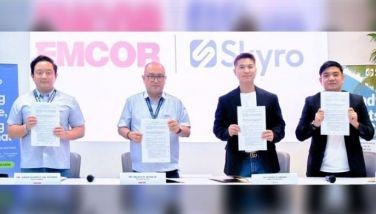Costs of irrigation investments in Philippines too large vs output
MANILA, Philippines — The government is not getting the most out of its investments in irrigation as costs far outweigh benefits, according to a paper published by state-run think tank Philippine Institute for Development Studies (PIDS).
In a recently-published discussion paper titled “Benefit-cost Analysis of the Resurgent Irrigation System Program of the Philippines,” PIDS said this was seen in irrigation investments made between 2008-2016.
“A comprehensive assessment of irrigation investment should examine not just the benefits, but also make a systematic comparison of benefits with costs,” said the policy research body.
“Across various assessment frames, the findings converge around the following: costs of irrigation investment are simply too large in comparison with expected benefits,” it added.
Irrigation investments in the country were ramped up anew beginning 2009 after the rice price crisis of 2008 that saw world prices of the staple exceed $1,000 per ton. This reinvigorated the policy of rice self-sufficiency.
The current Philippine Development Plan (PDP) 2017-2022 targets to expand irrigation coverage to 65.07 percent of potential area by end of period, up from the target of 57.33 percent in 2015.
PIDS said this problem primarily stems from the overestimation of the rate of return at the feasibility study stage.
Even for flagship irrigation projects like the Upper Pampanga River Integrated Irrigation System (UPRIIS), “assumptions on water availability, efficiency, water requirement, and sediment inflow, were systematically over/understated to raise the economic internal rate of return (EIRR),” the agency said.
The design was also “highly unrealistic,” as UPRIIS design engineers introduced double-gated water control structures that are “too sophisticated for farmers and watermasters to operate.” There was also “no interaction between design engineers and farmers about proper design and operations.”
PIDS said similar findings were seen in other irrigation projects during the period covered by the study.
“These findings are far from original. They simply continue a strand of research on irrigation programs of past decades, which also found that IRR (internal rate of return) at the feasibility study stage tend to overestimate actual returns,” it said.
“This begs the question of how irrigation projects gain approval at the feasibility stage,” it said.
PIDS said, however, that rather than invalidating the government’s entire policy and investment programming for irrigation, project evaluation at the feasibility stage must be stricter about making proper projections.
“Certainly, there will be any number of irrigation projects, making appropriate assumptions about future crop and non-crop benefits,” it said. “Project evaluation at the feasibility stage must be stricter about making credible projections concerning future crop and non-crop benefits of proposed irrigation projects.”
President Duterte signed into law last week the rice tariffication bill that liberalizes rice importation in the country.
As a safeguard measure for farmers who would be affected by this law, a Rice Competitiveness Enhancement Fund would be set up for the implementation of productivity-enhancing programs for the domestic rice sector.
This fund would be financed by rice import tariffs and a guaranteed minimum amount of P10 billion from the Treasury.
- Latest
- Trending































